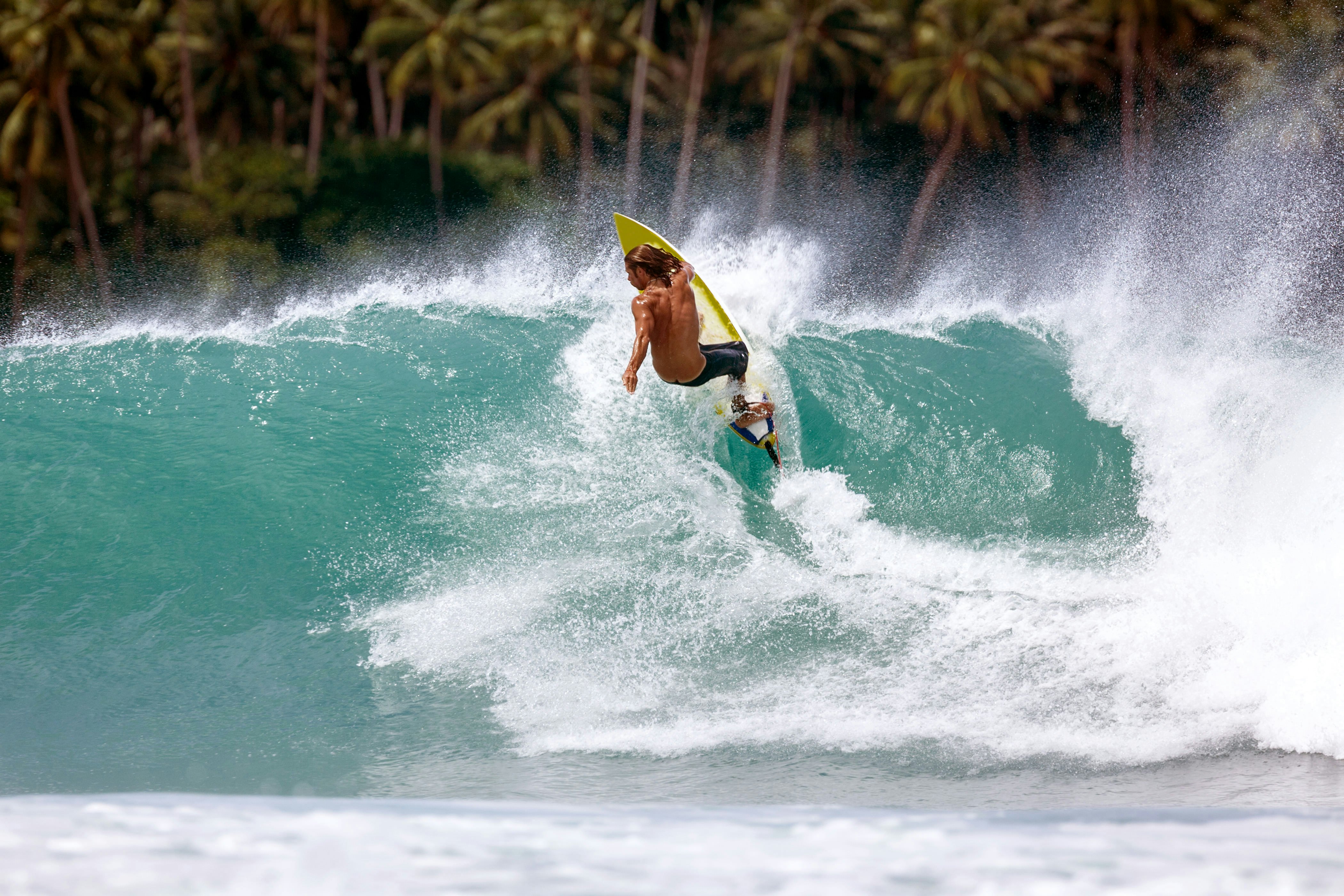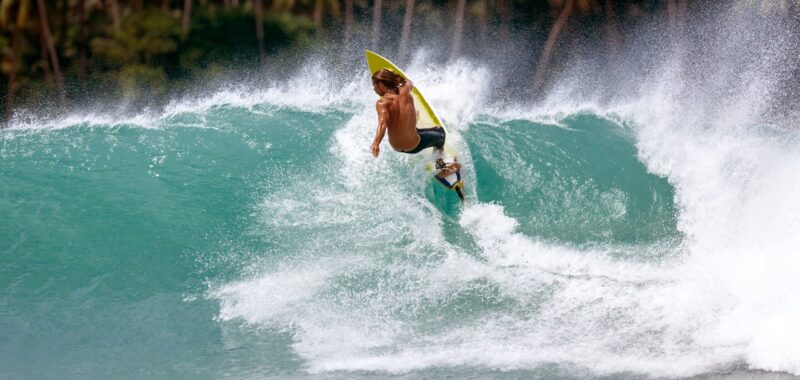With wildlife-filled rainforests, world-class waves, dramatic volcanoes and a magical undersea world, the Indonesian island of Sumatra both challenges and delights intrepid visitors.
Some travelers are drawn to Sumatra by the unforgettable surfing off the Mentawai Islands, or the lure of the island’s incredible underwater reefs. Sumatra’s national parks, once too difficult to navigate, are now tempting outdoors lovers with the secrets they hold. And the people of Sumatra – from the Muslim community in Aceh to Christians in Danau Toba and the matrilineal Minangkabau people of West Sumatra – will enrich your visit to Indonesia’s largest island.
Here’s how to get the best from Sumatra, whether you snatch just a few days on the island, or manage to carve out time for a month-long sojourn in paradise.

When is the best time to go?
The best time to visit Sumatra is from April until October, especially if surfing is on your radar. May to September is the dry season and the best time for wildlife sightings in the jungle. The monsoon season begins in November and runs through to March; it’s wet and travel will be more of a challenge, but you will find significant discounts on transport and accommodation.
Advertisement
How to get there
Medan is Sumatra’s primary international hub, with frequent flights from Kuala Namu International Airport (KNO) to cities in mainland Southeast Asian such as Singapore, Kuala Lumpur, Penang and Bangkok. In West Sumatra, Minangkabau International Airport receives flights from Kuala Lumpur.
If you fly into Medan from another Indonesian island via Malaysia, note that your single-entry visa expires when you leave Indonesia. You’ll need to purchase a new one on arrival when you reach Medan.
It’s also possible to reach Sumatra by sea from the Malaysian cities of Johor Bahru and Melaka, and from Singapore, via the Riau Islands.
How to get around
Organizing a driver and car is the easiest way to get around; talk to hotels, travel agencies or expats living in Sumatra for recommendations of trustworthy drivers. Check what the daily rate includes – it usually covers the car, fuel and road tolls, but you’ll also need to pay for your driver’s accommodation and food on multiday excursions. Most of the island is mountainous jungle and roads are sometimes poorly maintained, so don’t count on getting anywhere very quickly on Sumatra.
Long-distance buses are the source of many travel tales in Sumatra. Top-tier long-distance buses now have capsule beds for overnight journeys, but the majority are akin to mobile discos. Come prepared with a jacket or blanket for the arctic air-conditioning, and earplugs if you want some peace and quiet.
Flying is an affordable way to cover long distances. Reducing a 16-hour drive to a one-hour flight makes visiting far-flung destinations feasible on a tight schedule. Both Susi Air and Lion Air cover the region.
What to pack
Indonesia has a humid, tropical climate, so bring breathable, lightweight clothing to cover most days of your trip. However, it can be surprisingly chilly in the highlands; if you plan to do some trekking or volcano climbing, you will appreciate some warmer layers, as well as appropriate footwear.
Some 87% of Indonesians are Muslim, and while dress codes are relatively relaxed, you are likely to feel more comfortable (and appear more respectful) if you wear long pants and clothes that cover your shoulders, particularly in rural areas, where people tend to be more traditional – this includes Aceh, where Islamic laws are in place.
Also don’t forget to pack a water bottle, insect repellent, a torch for nights, and reef-friendly sunscreen.

Get a taste of Sumatra in 3 days
Best itinerary for volcano climbing and wildlife spotting
Distance: 294km (182 miles)
Start your trip in Medan, the island’s busy capital city, then head to Bukit Lawang. This lovely village is strung out along the fast-flowing Sungai Bohorok river, and bordered by the dense, vertically rising jungles of Gunung Leuser National Park. Its legend is built around the orang-utan rehabilitation center set up here in 1973, and although the feeding platform has closed, this is still the best place in Sumatra to spot wild orang-utans who are habituated to the presence of humans while hiking.
Advertisement
Hiking aside, Bukit Lawang is a very traveler-friendly place – many visitors while away multiple days lounging in hammocks, splashing or tubing in the river and enjoying some of the best-value jungle resorts in Sumatra. But as you’re on a tight timeframe, you’ll need to rise by 9am the following morning for a half-day guided trek to spot wildlife. Along with orang-utans, Gunung Leuser National Park is home to elephants, Sumatran tigers, rhinoceroses and varied birdlife, including the distinctively noisy rhinoceros hornbill.
Next, drive to Berastagi along 135km (83 miles) of winding roads. Here, you can dine at one of Berastagi’s vibrant night-market stalls before going to bed early, so you’re ready for your 4am wake-up call to climb 2181m (7155ft) Gunung Sibayak. Watching the sunrise from this still steaming volcano will go down in your memoirs as one of life’s most magical experiences. Afterwards, soak in the hot springs that line the valley at venues such as Mitra Sibayak or Pariban.
You’ll no doubt be ready for an early night at your riverside accommodation before you meander back to Medan for your flight out the next day.

A fortnight seeing Sumatra’s highlights
Best for hiking, surfing and hammock lounging
Distance: 858km (533 miles), plus ferries to the outer islands
If you’ve got two weeks, kick off your trip with our three-day itinerary, but rather than returning to Medan from Berastagi, continue to Danau Toba (Lake Toba). Found up among Sumatra’s volcanic peaks, this grand, ocean-blue lake has been part of traveller folklore for decades, and the area is the home of the amiable Christian Batak people. These days, Tuk Tuk – the laid-back village on the lake island of Samosir – is firmly on the beaten Sumatran overland path, but it’s still one of the undisputed highlights of North Sumatra.
Spend a few days enjoying Tuk Tuk’s chilled-out vibe. You’ll have plenty of opportunities to see waterfalls, swim in the chilly lake waters, and go trekking (best with a guide as tracks are not well marked). From Danau Toba, you are close (in Sumatran terms) to Singkil, in Aceh province, where you can join a “swamp tour” – but it will still take you a day to get here.
Singkil is a remote, sleepy port town at the mouth of the Sungai Alas, and it’s the departure point for boat adventures to the Banyak Islands, Pulau Nias and Pulau Simeulue. However, it’s worth lingering here for a day to explore the swampy surroundings, which are home to crocodiles, wild orang-utans and other wildlife wonders.
Next, catch the ferry to Banyak Islands for three nights of quality island time. Many visitors to the Banyaks are surfers, and there are some world-class surf spots here off Pulau Tuangku and Pulau Bangkaru. There reefs off the Banyaks also teem with colorful fish and corals, with fabulous snorkeling possibilities off the coast of almost any island.
The visibility is excellent and most lodgings rent out masks and snorkels; standout islands for snorkeling include Pulau Asok and Pulau Pabisi. Once you’ve had your fill of island time, it’s a good day’s travel back to Medan via Singkil.
Planning tip: Buses connect major hubs such as Medan, Tuk Tuk and Singkil, but a chartered car and driver can be a handy alternative, particularly if you can share costs with a few other travelers.

A month-long Sumatra odyssey
Best for an off-the-beaten-track adventure
Distance: 1717km (1066 miles), includes a domestic flight (and ferries to outer islands)
Begin this trip in the West Sumatran city of Padang, a handy transport hub with good air, boat and road connections to major regional attractions. From here, head to the Mentawai Islands, a region that was mostly isolated until the 19th century due to strong winds, unpredictable currents and razor-sharp reefs.
Tourism has developed here in recent years, with a new airport on Pulau Sipora (Rokot Airport, also known as Mentawai Airport) opening in 2023. It receives flights from Padang with Susi Air, but the islands still feel like an idyllic escape.
Surfers flock to the islands for their legendary waves, but the scene is well established and there are few completely undiscovered surf breaks these days. Intrepid travelers also come to spend time with the island’s Indigenous – and ornately tattooed – hunter-gatherer peoples. The Mentawai Islands are also famous for endemic primates such as the pig-tailed snub-nosed monkey, Mentawai macaque, Mentawai leaf monkey and the dwarf siamang.
Pulau Siberut is best known of the islands thanks to its status as a UN Biosphere Reserve, while Pulau Sipora, with its airport, is the pickup point for resorts in the surfing area known as the Playgrounds. Pulau Pagai Utara (North Pagai) is getting fresh attention, with new resorts opening on its west coast near the consistent Macaronis surf break.

If you have the time, and want that feeling of going on a far-flung travel quest, you can charter a boat for 10 to 12 days and see where you end up. It’s best to choose your friends and your vessel wisely – you’re about to spend a substantial amount of time in a relatively small, confined space. Joining an organized tour with a friend, or by yourself, is a great opportunity to make new friends; sleeping quarters range from dorm-style shared bedrooms to boats with more comfortable private rooms.
After you return to Padang from Mentawai, your next stop should be Kerinci, a stunning mountain valley tucked away high in the Bukit Barisan highlands on Jambi’s western border. Many of the cool, lush forests here are protected by the Kerinci Seblat National Park, one of the last strongholds of the Sumatran tiger.
The valley’s many lakes and jungle-shrouded mountains and volcanoes make it a big draw for hikers in search of a truly off-the-beaten-track adventure. Here, you can hike up 3805m (12,484ft) Gunung Kerinci for a classic Indonesian volcano experience, or take on a three-day Sumatra Tiger Trek.
Next on this deep dive into Sumatra, fly over to Medan and head straight to Danau Toba for hiking and hot springs soaking (see the fortnight-long itinerary above for details).

After some lake and jungle time, head to Banda Aceh, the surprisingly relaxed and charming provincial capital of Aceh province. Stop for a day or two before ferrying out to Pulau Weh to dive and snorkel.
It’s hard to imagine today that Banda Aceh bore the brunt of the 2004 Boxing Day tsunami, with 61,000 killed and much of the city destroyed. The magnificent Baiturahman Grand Mosque – one of Indonesia’s most beautiful mosques – stands as the city’s crowning glory, along with the poignant Tsunami Museum.
On the tiny island of Pulau Weh, explore pristine beaches, jungles and clear waters, or just chill in a hammock at your bungalow. Both figuratively and geographically, Pulau Weh is the cherry on top for many visitors to Sumatra. Close out the trip by returning to Medan to board a flight home.
Planning tip: Keep track of your visa’s expiry date and bear in mind your travel time to the international airport in Medan at the end of the trip – it may be hard to leave this island paradise!
This article was adapted from Lonely Planet’s Indonesia guidebook from July 2024.

